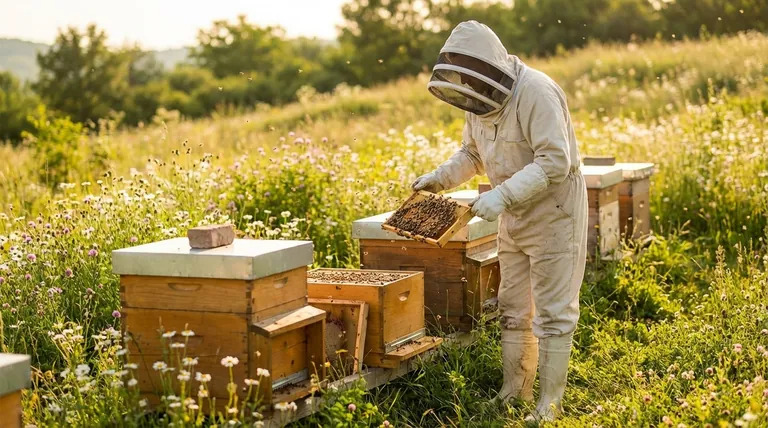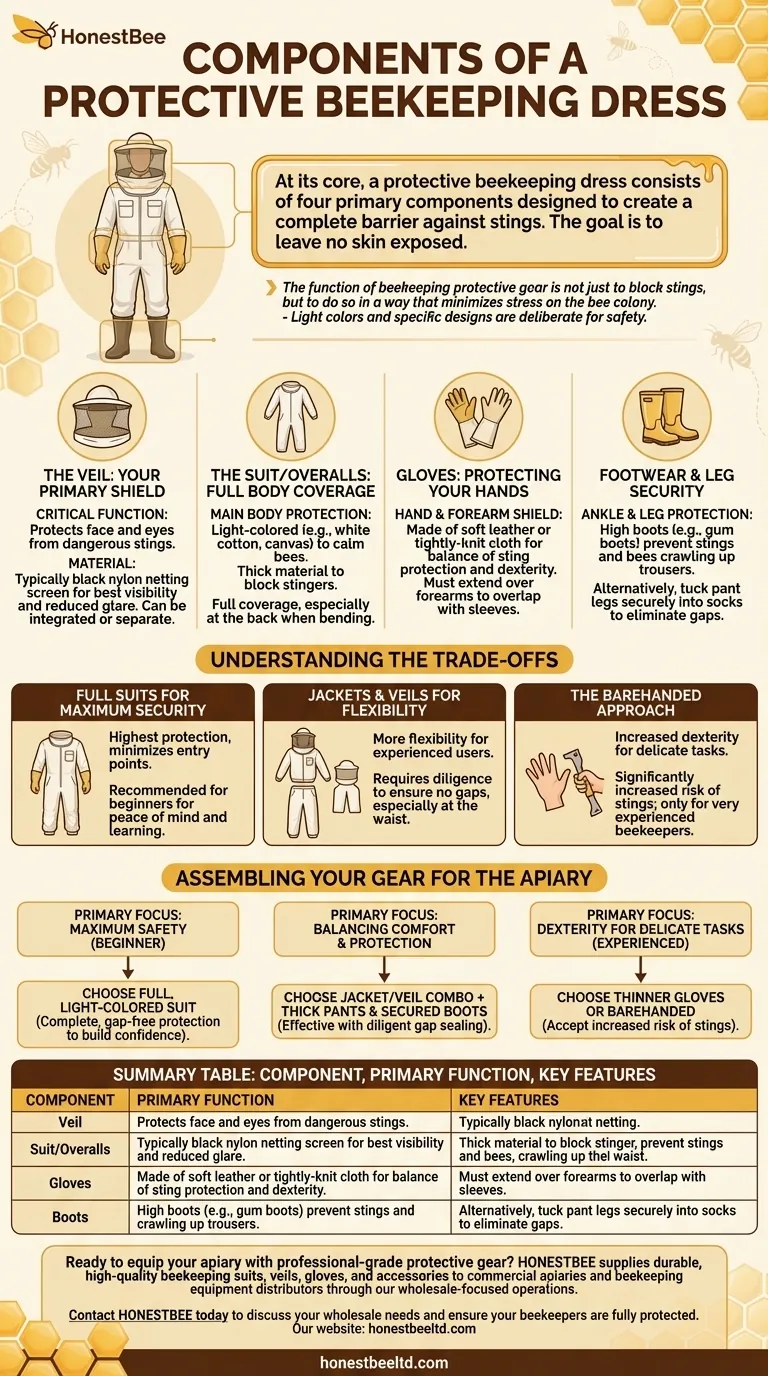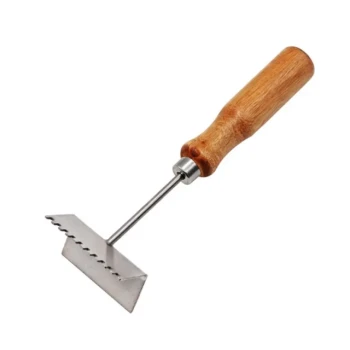At its core, a protective beekeeping dress consists of four primary components designed to create a complete barrier against stings. These are a veil to protect the face, overalls or a suit for the body, gloves for the hands, and high boots to secure the ankles and legs. The goal is to leave no skin exposed and no entry points for bees.
The function of beekeeping protective gear is not just to block stings, but to do so in a way that minimizes stress on the bee colony. The choice of light-colored, thick materials and specific component designs is a deliberate strategy for the safety of both the beekeeper and the bees.

Deconstructing the Protective Gear
Each component of the protective dress serves a specific and critical function. Understanding the purpose of each piece helps you appreciate why full and proper coverage is essential, especially when you are beginning.
The Veil: Your Primary Shield
A bee veil is the most critical piece of equipment, as stings to the face and eyes are particularly dangerous and painful. It is typically made of a black nylon netting screen.
The black color is intentional; it provides the best visibility by reducing glare, allowing you to clearly observe the bees and the hive's condition. Veils can be purchased separately or, more commonly, integrated into a beekeeping jacket or full suit.
The Suit or Overalls: Full Body Coverage
The main body is protected by overalls or a full suit. These are preferably made of light-colored, thick materials like cotton, canvas, or denim.
Light colors, especially white, are less likely to be perceived as a threat by bees, helping to keep the colony calm. The material must be thick enough to prevent a bee's stinger from reaching your skin. Ensure the garment provides full coverage, especially at the back when you bend over.
Gloves: Protecting Your Hands
Gloves shield your hands and forearms, the parts of your body that interact most directly with the hive. They are often made of soft leather or tightly-knit cloth.
The material must provide a balance between sting protection and the dexterity needed to handle frames and tools. The gloves should extend well over your forearms to securely overlap with the sleeves of your suit or jacket.
Footwear and Leg Security
High boots, such as gum boots, protect your ankles from stings and prevent bees from crawling up inside your trousers. This is a common entry point that must be secured.
As an alternative to boots, you can tuck your pant legs securely into your socks. The key is to eliminate any gap between your pants and your footwear.
Understanding the Trade-offs
While maximum protection is the priority for new beekeepers, different setups offer varying levels of comfort and flexibility. The choice often comes down to experience and personal risk tolerance.
Full Suits for Maximum Security
A full, one-piece suit offers the highest level of protection by minimizing potential entry points for bees, especially around the waist. This is the recommended standard for beginners, as it provides peace of mind and allows you to focus on learning bee behavior.
Jackets and Veils for Flexibility
More experienced beekeepers sometimes opt for a jacket-and-veil combination. This is paired with thick, separate pants like denim jeans or canvas painter's pants. While offering more flexibility, this setup requires diligence to ensure there is no gap at the waist where bees could enter.
The Barehanded Approach
With experience, some beekeepers choose to work without gloves to gain better dexterity and a more sensitive feel for the hive components. This significantly increases the risk of stings and is a personal choice that should only be considered after you fully understand your bees and your own tolerance for stings.
Assembling Your Gear for the Apiary
Your choice of protective gear should directly support your experience level and safety requirements.
- If your primary focus is maximum safety as a beginner: Choose a full, light-colored beekeeping suit to ensure complete, gap-free protection and build your confidence.
- If your primary focus is balancing comfort and protection: A high-quality jacket/veil combo paired with thick pants and secured boots can be effective, provided you are diligent about sealing all gaps.
- If your primary focus is dexterity for delicate tasks: Experienced beekeepers may opt for thinner nitrile gloves or go barehanded, fully accepting the increased risk of stings.
Dressing for the apiary is your first step in ensuring a safe, calm, and productive interaction with your bees.
Summary Table:
| Component | Primary Function | Key Features |
|---|---|---|
| Veil | Protects face and eyes | Black nylon netting for visibility; often integrated into a suit or jacket |
| Suit/Overalls | Protects the torso and legs | Light-colored, thick materials (e.g., cotton, canvas) to calm bees and block stingers |
| Gloves | Shields hands and forearms | Soft leather or tightly-knit cloth for a balance of protection and dexterity |
| Boots | Secures ankles and legs | High boots (e.g., gum boots) to prevent bees from crawling up trousers |
Ready to equip your apiary with professional-grade protective gear?
HONESTBEE supplies durable, high-quality beekeeping suits, veils, gloves, and accessories to commercial apiaries and beekeeping equipment distributors through our wholesale-focused operations. Our gear is designed for maximum safety, comfort, and longevity, helping your team work confidently and efficiently.
Contact HONESTBEE today to discuss your wholesale needs and ensure your beekeepers are fully protected.
Visual Guide

Related Products
- 3 Layer Mesh Vented Sting Proof Beekeeping Suit with Hat and Veil
- Cotton Beekeeping Suit and Round Hat with Veil Bee Keeper Protective Gear
- Vented Beekeeping Jacket with Hood and Veil for Beekeepers
- Yellow Plastic Bucket Pail Perch for Beekeeping
- Long Langstroth Style Horizontal Top Bar Hive for Wholesale
People Also Ask
- What are the key features to look for in beekeeping clothing? Ensure Maximum Safety & Comfort
- What are the benefits of a fully ventilated beekeeping suit? Stay Cool and Protected in Hot Climates
- What are the advantages of reinforced stitching and durable zippers in beekeeping suits? Ensure Maximum Safety & Longevity
- What should be considered regarding the color of beekeeping clothing? Ensure Your Safety and Keep Bees Calm
- What are the key features of the 3-layer mesh gear designed for beekeeping? Superior Protection & Ventilation



















